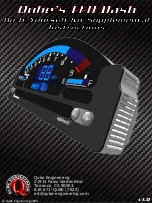
When the SAB deploys, it opens the seam on the out-
board side of the seatback’s trim cover. The inflating
SAB deploys through the seat seam into the space
between the occupant and the door. The SAB moves at
a very high speed and with such a high force that it
could injure occupants if they are not seated properly,
or if items are positioned in the area where the SAB
inflates. Children are at an even greater risk of injury
from a deploying air bag.
WARNING!
Do not use accessory seat covers or place objects
between you and the Side Air Bags; the performance
could be adversely affected and/or objects could be
pushed into you, causing serious injury.
Side Impacts
The Side Air Bags are designed to activate in certain
side impacts. The Occupant Restraint Controller (ORC)
determines whether the deployment of the Side Air
Bags in a particular impact event is appropriate, based
on the severity and type of collision. The side impact
sensors aid the ORC in determining the appropriate
response to impact events. The system is calibrated to
deploy the Side Air Bags on the impact side of the
vehicle during impacts that require Side Air Bag occu-
pant protection. In side impacts, the Side Air Bags
deploy independently; a left side impact deploys the left
Side Air Bags only and a right-side impact deploys the
right Side Air Bags only. Vehicle damage by itself is not
a good indicator of whether or not Side Air Bags should
have deployed.
The Side Air Bags will not deploy in all side collisions,
including some collisions at certain angles, or some
side collisions that do not impact the area of the pas-
senger compartment. The Side Air Bags may deploy
during angled or offset frontal collisions where the front
air bags deploy.
Side Air Bags are a supplement to the seat belt
restraint system. Side Air Bags deploy in less time than
it takes to blink your eyes.
WARNING!
•
Occupants, including children, who are up against
or very close to Side Air Bags can be seriously
injured or killed. Occupants, including children,
should never lean on or sleep against the door,
side windows, or area where the side air bags
inflate, even if they are in an infant or child
restraint.
•
Seat belts (and child restraints where appropriate)
are necessary for your protection in all collisions.
They also help keep you in position, away from an
inflating Side Air Bag. To get the best protection
from the Side Air Bags, occupants must wear their
seat belts properly and sit upright with their backs
(Continued)
WARNING!
against the seats. Children must be properly
restrained in a child restraint or booster seat that
is appropriate for the size of the child.
WARNING!
•
Side Air Bags need room to inflate. Do not lean
against the door or window. Sit upright in the cen-
ter of the seat.
•
Being too close to the Side Air Bags during deploy-
ment could cause you to be severely injured or
killed.
•
Relying on the Side Air Bags alone could lead to
more severe injuries in a collision. The Side Air
Bags work with your seat belt to restrain you prop-
erly. In some collisions, Side Air Bags won’t deploy
at all. Always wear your seat belt even though you
have Side Air Bags.
NOTE:
Air bag covers may not be obvious in the interior trim,
but they will open during air bag deployment.
Air Bag System Components
NOTE:
The Occupant Restraint Controller (ORC) monitors the
internal circuits and interconnecting wiring associated
with electrical Air Bag System Components listed below:
•
Occupant Restraint Controller (ORC)
•
Air Bag Warning Light
•
Steering Wheel and Column
Supplemental Seat-Mounted Side Air Bag Label
268
SAFETY
Summary of Contents for GLADIATOR 2022
Page 101: ...GETTING TO KNOW YOUR INSTRUMENT PANEL GASOLINE INSTRUMENT CLUSTERS 99 3...
Page 102: ...100 GETTING TO KNOW YOUR INSTRUMENT PANEL...
Page 104: ...DIESEL INSTRUMENT CLUSTERS 102 GETTING TO KNOW YOUR INSTRUMENT PANEL...
Page 105: ...GETTING TO KNOW YOUR INSTRUMENT PANEL 103 3...
Page 327: ...Power Distribution Center Location Gas Engine SERVICING AND MAINTENANCE 325 8...
Page 378: ......
















































